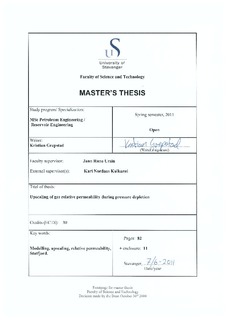| dc.description.abstract | Pressure depletion of an oil reservoir will result in release of dissolved gas when the bubble point of the oil is reached in the reservoir. This liberated gas will segregate upwards in the reservoir with low mobility until a vertical flow barrier is met by the gas. Liberated gas will accumulate below this barrier and create thin "layers" with high gas saturation, where the mobility of gas becomes high. These thin layers with high mobility will result in a relatively quick production of the liberated gas compared to "thick" layers used in conventional reservoir simulation grid, with low average gas saturation. In order to simulate this effect more accurately, a method for upscaling the relative permeability and critical gas saturation is proposed in this thesis. Through simulation and analysis of the results it can be established a method of upscaling a 2D reservoir simulation model. However, without further simulation and analysis of a 3D scenario, it is not possible to establish if the method is adequate in a 3D scenario. All conclusions made in this thesis are considered for a 2D simulation model only. However, for the Statfjord Field, which is investigated in this thesis, it is still reasonable to assume that a 3D upscaling would be quite similar, assuming linear flow towards the top of the structure. The assumption of linear flow towards the top of the structure is based on observations of former injected gas with tracers. Conventional simulation grid is observed to underestimate the gas production when gas is liberated in the reservoir. The recommendations presented, in order to include the effect, is divided into two different cases in this thesis; recommendations when creating a new reservoir simulation model and recommendations when upscaling an already existing reservoir simulation model. If a simulation model is to be created, an adequately thin layer created below a vertical flow barrier will make Eclipse able to simulate the effect of gas creating a high mobility layer. The thickness of the layer must be evaluated in each separate situation, depending on the amount of liberated gas expected. If a reservoir simulation model already exists, an upscaling method is a more practical approach. A small area which is representative for a larger region is chosen. Layers located below a vertical flow barrier are refined into adequately thin layers, and a transmissibility weighted average relative gas permeability is calculated and plotted against pore volume weighted average gas saturation. A Corey relative gas permeability is adapted as a best match by varying the Corey exponent and critical gas saturation. The Corey relative gas permeability tables and critical gas saturations found are assigned to the original layer, which was refined, as upscaled parameters. If the area chosen for upscaling is representative for a larger region, the upscaled parameters can be assigned in the respective layers in the larger region. Reservoir simulation models studied in this thesis originates from the full field reservoir simulation model of the Statfjord Field. Analyzing the upscaled simulation model indicates a significant increase in total cumulative gas production, as high as 7 % through the period investigated. This may affect the estimated gas reserves in the Statfjord Field, and is of great importance in an economical aspect. | no_NO |
